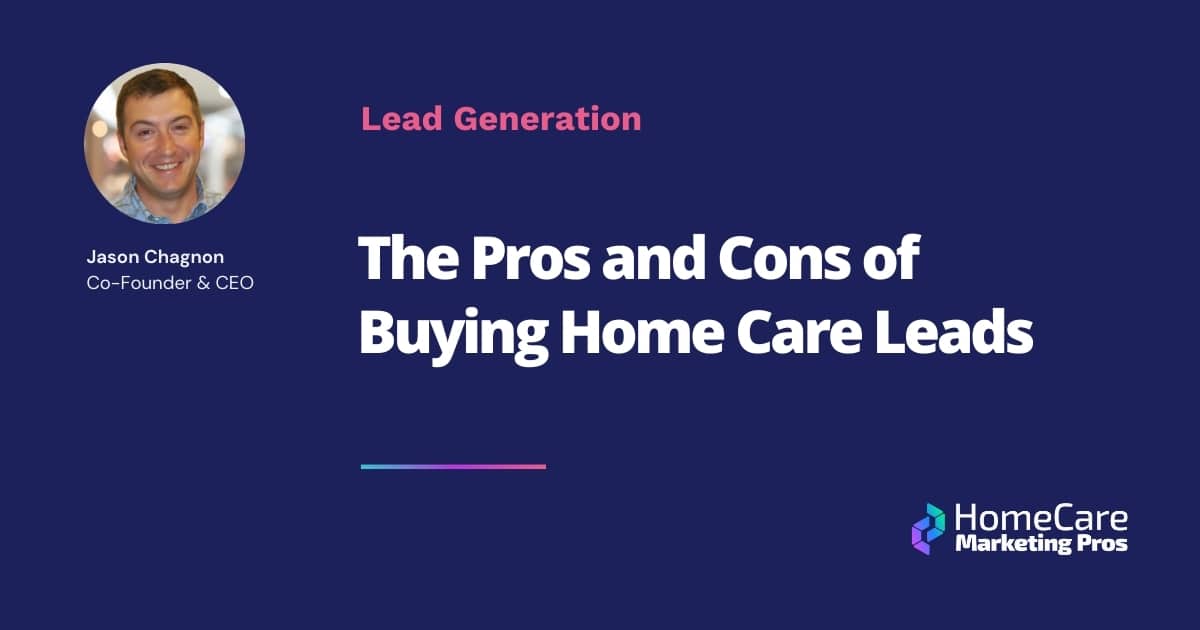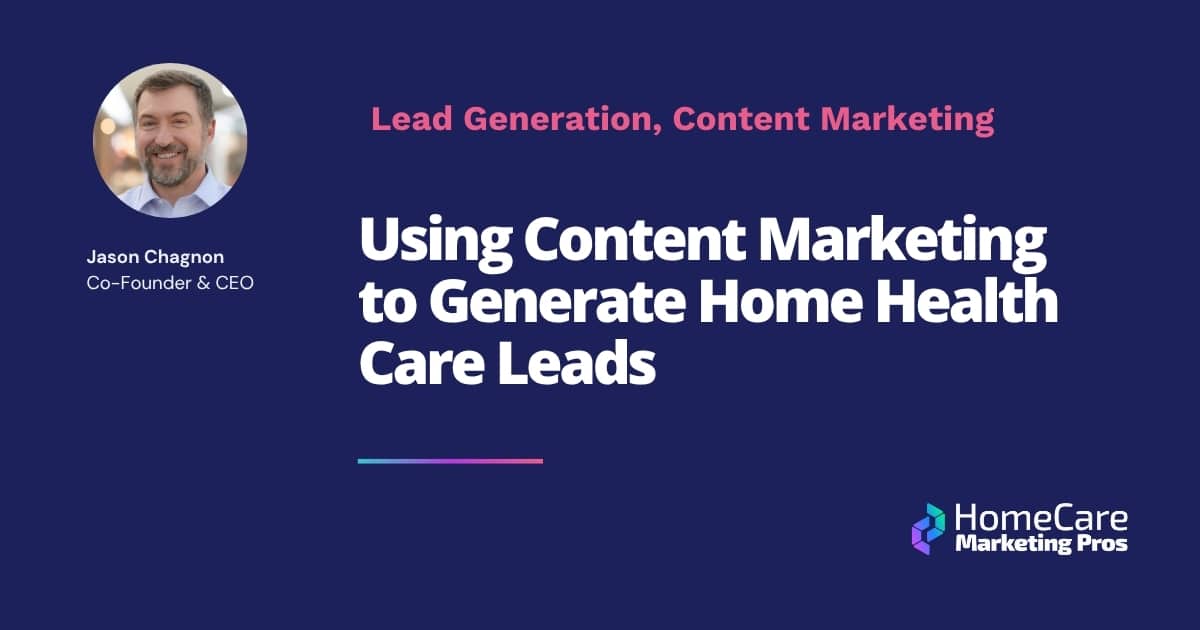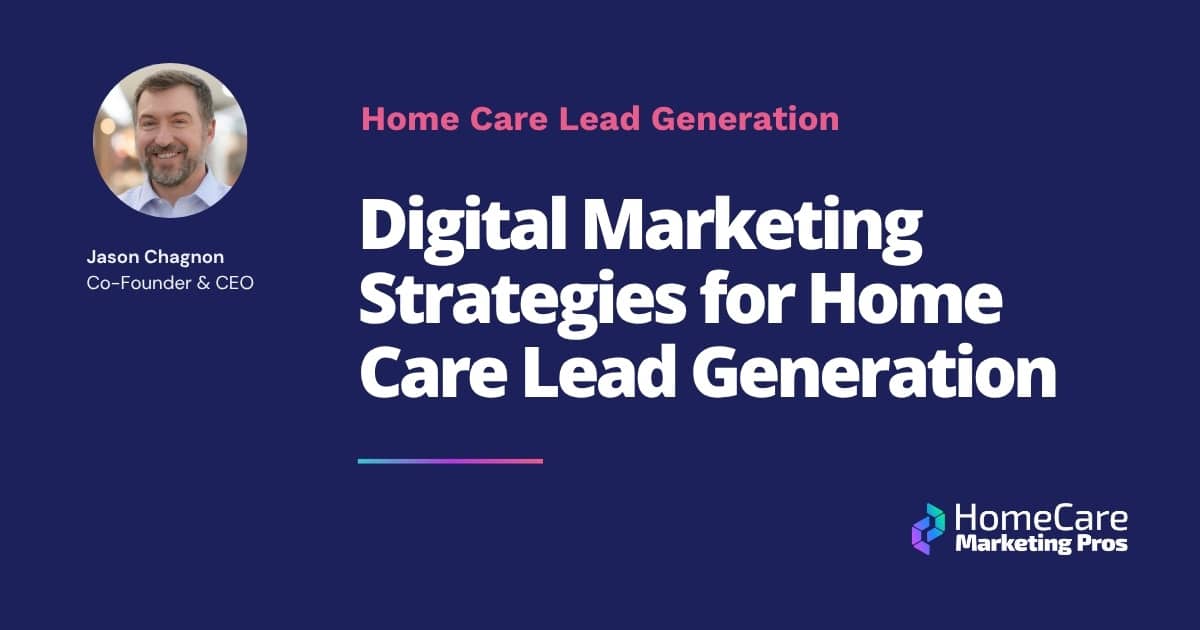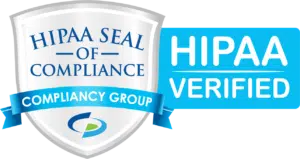
Jason Chagnon
Co-Founder & CEO
Reading time - 8 minutes

For home care agencies, finding new clients is often one of the hardest parts of running a home care business. Senior care lead generation takes place within the broader healthcare industry, which faces unique challenges such as regulatory compliance, building trust, and standing out in a competitive marketing environment. Seniors and their families are actively searching for quality care, and making the connection at just the right moment requires both strategy and reliable lead sources. Search engine optimization and a professional website are essential for attracting new clients and showcasing services. Customer reviews and social proof also play a crucial role in building trust with potential clients, as they increase online visibility and generate leads.
In this post, we look at some of the top senior care lead providers in today’s market—names your prospects likely already know, like A Place for Mom and Caring.com. We’ll dig into how each operates, what kinds of leads they deliver, and how their pricing works. Whether you’re curious where to buy home care leads or are just comparing companies, this guide aims to give you enough insight to choose wisely.
What Separates Strong Lead Generation Providers from the Rest
Not all leads are valuable. The difference lies in how companies source, screen, and distribute their inquiries. The most effective providers don’t just create demand—they qualify prospects before passing them to you, ensuring you receive qualified leads that are more likely to convert.
Pricing structures also vary. Some home care lead networks operate on a commission or referral-fee basis, where payment is contingent upon conversion. Others use pay-per-lead or subscription models, charging for each inquiry irrespective of outcome. Which model fits you best depends on your risk tolerance and sales cycle.
Transparency is equally critical. For any agency choosing a company that’s generating leads, understanding the importance of transparency and tracking is essential to ensure accountability and optimize results. Respected providers typically outline how leads are generated, offer dashboards or integrations to track performance, and maintain responsiveness and support. These dashboards also allow you to monitor the effectiveness of different campaigns and aspects of your digital marketing strategy, helping you refine your approach over time.
Finally, features like exclusive territories or localized targeting can limit your competition for the same lead pool—particularly vital for a smaller home care provider or agencies working in tighter geographies. An agency can benefit greatly from partnering with a provider that has a strong track record of delivering results and client satisfaction.
A Place for Mom
A Place for Mom is widely recognized as the largest home care referral network in North America. Their platform connects patients to participating home care providers across the U.S. and Canada. According to their site, their “Family Lead Program” operates on a pay-per-lead model with 100% verified leads, no long-term contract, and no monthly fees required to join. This program is designed to generate leads for home care providers.
In addition, A Place for Mom offers a CRM tool which enables partner communities to manage inbound referrals, follow-up activity, performance tracking, and conversion status. This integration is useful to ensure the referral flows directly into your lead management system, minimizing delays or manual transfer errors.
On their “How Our Service Works” page, A Place for Mom also states that their service is free for families—because they are compensated by participating providers when those families find a match.
Their referral model thus encourages providers to pay when value is delivered, rather than forcing arbitrary subscription costs on both sides. The system is specifically designed to drive leads for providers.
However, their lead distribution can be highly competitive. Marketing and sales consultants note that A Place for Mom often sends the same referral to multiple partners, meaning the fastest responder frequently has the edge. In a competitive market, this “speed to lead” dynamic is a major factor in whether referrals convert to business.
A robust CRM and follow-up process also helps manage relationships with current clients, ensuring ongoing engagement and satisfaction.
Takeaway: Because A Place for Mom is a large, established brand and company, using them can provide volume and scale—but you should be clear on your terms and internal processes to maximize conversion from those leads.
Caring.com
Caring.com operates an extensive network of senior care service listings, connecting consumers with care options via their directory, editorial content, and consumer reviews. Their partner site describes their work as passing inquiries, leads, and referrals to provider listings, including home care. They maintain a “Get Referrals” pathway for providers to join their network, increasing the chances of appearing in search results and being found by potential clients.
One interesting detail is their emphasis on reviews. According to Caring, listings with any reviews can generate up to 14× more leads than those with zero reviews. For higher-volume listings with 15+ reviews, their partners have reported conversion rates far above those with minimal reviews. This suggests that part of Caring’s value lies not just in lead volume, but in improving quality through reputation signals. Positive feedback from customers provides social proof, demonstrating customer satisfaction and helping to build trust with potential patients or clients.
Caring also encourages partners to keep their rate data updated in their partner portals. Because Caring.com’s Family Advisors perform phone-level screening, having accurate cost and community rate info helps them make more financially qualified referrals to your listing.
In their referral operations, Caring claims that after a Family Advisor engages a searcher, they immediately send alerts to partner communities via email. They emphasize that speed to response is essential and that duplicate lead reporting is part of the referral contract—partners must flag duplicates within five business days or risk paying multiple referral fees. This process helps connect providers with people searching for senior care options and ensures that potential clients receive timely responses.
Takeaway: While Caring’s structure often means some cost to the provider, many users cite the quality, legitimacy, and brand trust of inquiries as justifying the investment—especially for home care agencies. Satisfied customers and strong customer reviews further enhance credibility and help listings stand out in search results.
SeniorHousingNet (Now Part of Caring)
In 2020, Caring.com acquired SeniorHousingNet, expanding their directory and ad reach into the 55+ / active adult space. This means a listing under Caring may benefit from additional visibility through integrated platforms and increased web traffic.
With the acquisition, Caring extended its footprint into active adult and 55+ markets, enhancing lead depth and breadth. The combined reach provides a richer pathway for providers to be discovered by families at different stages of their care-seeking journey, especially those serving seniors.
Niche and Regional Home Care Leads Provider
In addition to large national platforms, a smaller or regional home care leads specialist can offer strong value—particularly to home care agencies who offer in-home care services. These providers often operate in localized markets, delivering a steady stream of qualified leads that are geographically relevant and less saturated by competition. Agencies seeking more home care clients often turn to these providers to increase visibility and attract more business.
Because they serve tighter service areas, they may offer exclusive leads in specific ZIP codes, or caps on the number of leads per provider—boosting lead quality and conversion potential. Pricing tends to be more flexible and lower compared with national networks. The trade-off is lower volume overall, so you may need to use multiple regional providers or supplement with larger platforms to reach your growth targets.
Especially for smaller organizations, partnering with these niche lead sources often delivers a higher ROI, fewer wasted leads and more control over budget. The dedicated team behind these providers can offer personalized support and expertise to help agencies grow and secure more home care clients.
Maximizing Value from Purchased Leads
Regardless of provider, your success depends heavily on how you manage incoming leads. Because families often decide quickly, following up immediately can make or break the opportunity. Studies of response behavior in the senior care space confirm that the first responder often wins.
Make sure your internal systems are set up to ingest leads seamlessly—ideally via integration rather than manual data entry—to minimize delay and errors. For example, establishing automated workflows with your CRM can help you respond instantly.
Tracking conversions is also essential. Over time, you’ll see which channels deliver the best ROI in your market.
Finally, don’t rely solely on purchased leads. Combine them with smart marketing strategies to generate leads for your home care business—such as leveraging paid channels and running targeted campaigns, including Google Ads, to quickly build your pipeline. For long-term growth, use lead generation techniques like local SEO (including creating a free business profile to boost local visibility), referral marketing, partnerships with trusted advisors (e.g. elder law attorneys or geriatric care managers), social media, email campaigns, and collaborating with healthcare providers. Community outreach, such as organizing workshops for family caregivers, is also an excellent opportunity to engage your audience and promote your services. A balanced approach helps stabilize lead volume and reduce dependency on any single provider.
Conclusion
Effective lead acquisition is a key driver of growth in the senior care industry. Large referral networks like A Place for Mom and Caring.com deliver scale, brand awareness, and qualified inquiries—but they also come with cost and competition. SeniorHousingNet’s integration into Caring broadens reach, while regional and niche lead providers offer tighter geographic targeting and potentially better ROI for local home care businesses.
To choose the right mix, focus on lead quality, response speed, integration and tracking ability. Start with modest investments, test and compare providers, and scale with those who deliver measurable results. Ultimately, when you turn more leads into clients, you’ll transform the growth trajectory of your care business—and help more families access the support they need.
Need help getting leads, setting up CRM automations, and attracting clients organically? Let’s chat!











